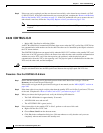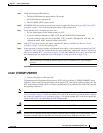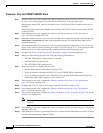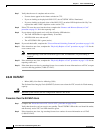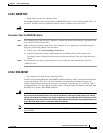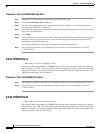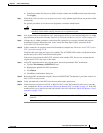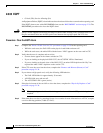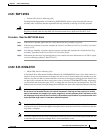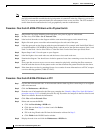
2-48
Cisco ONS 15327 Troubleshooting Guide, R3.4
March 2004
Chapter 2 Alarm Troubleshooting
Alarm Procedures
2.6.49 EOC
• Major (MJ), Non-Service Affecting (NSA)
The SONET DCC Termination Failure (EOC) alarm occurs when the ONS 15327 loses its data
communications channel. The DCC is three bytes, D1 through D3, in the SONET overhead that convey
information about Operation, Administration, Maintenance, and Provisioning (OAM&P). The
ONS 15327 uses the DCC on the SONET section layer to communicate network management
information.
Warning
Invisible laser radiation might be emitted from the end of the unterminated fiber cable or connector.
Do not stare into the beam directly with optical instruments. Viewing the laser output with certain
optical instruments (for example, eye loupes, magnifiers, and microscopes) within a distance of 100
mm might pose an eye hazard. Use of controls or adjustments or performance of procedures other than
those specified might result in hazardous radiation exposure.
Caution Always use the supplied electrostatic discharge wristband when working with a powered ONS 15327.
Plug the wristband cable into the ESD jack located between the top high-speed and XTC slots.
Note If a circuit shows an incomplete state when the EOC alarm is raised, it occurs when the logical circuit is
in place and will be able to carry traffic when the DCC termination issue is resolved. You do not need to
delete the circuit when troubleshooting this alarm.
Procedure: Clear the EOC Alarm
Step 1 If an LOS (DS-1) alarm (see page 2-82) is also reported, complete the “Clear the LOS (DS-1) Alarm”
procedure on page 2-82.
Step 2 If the alarm does not clear on the reporting node, verify the physical connections between the cards and
the fiber-optic cables that are configured to carry DCC traffic.
Step 3 If the physical connections are correct and configured to carry DCC traffic, verify that both ends of the
fiber span have in-service (IS) ports by checking that the ACT LED on each OC-N card is illuminated.
Step 4 If the ACT LEDs on OC-N cards are illuminated, complete the “Verify or Create Node DCC
Terminations” procedure on page 2-126 to verify that the DCC is provisioned for the ports at both ends
of the fiber span.
Step 5 Repeat Step 4 at the adjacent nodes.
Step 6 If DCC is provisioned for the ends of the span, verify that the OC-N port is active and in service:
a. Confirm that the OC-N card shows a green LED in CTC or on the physical card.
A green LED indicates an active card. An amber LED indicates a standby card.
b. To determine whether the OC-N port is in service, double-click the card in CTC to display the card
view.
c. Click the Provisioning > Line tabs.
d. Verify that the State column lists the port as in service (IS).



